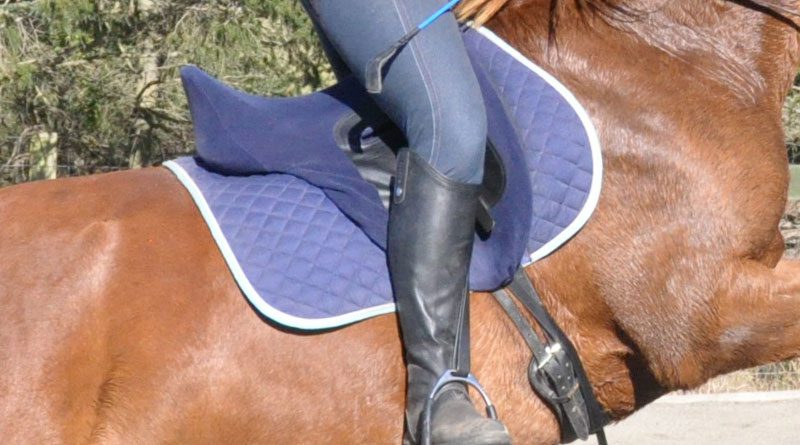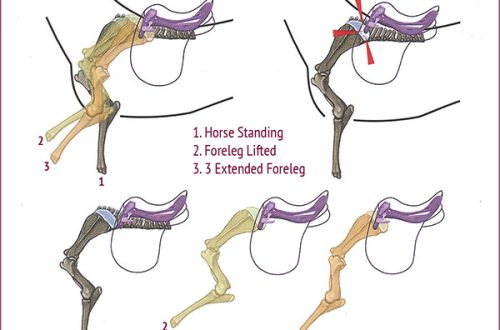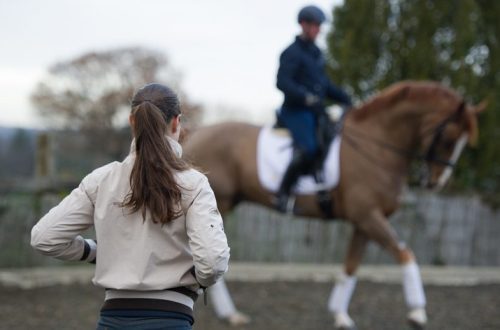
Can you jump in a dressage saddle?
Can you jump in a dressage saddle?
The rider must coordinate his center of gravity with the center of the horse. Depending on the discipline of the equestrian sport and the situation, the location of the center of gravity may depend on the chosen saddle.
Riders, especially beginners, often wonder how “harmful” or “wrong” it is to jump in a dressage saddle or ride in show jumping.
Theoretically, at least assuming that this does not involve regular work, but rather “one-time” exercises, there should not be problems with real long-term consequences.
But, if you want to pick a discipline and do it to the fullest, there are good reasons to choose a saddle that fits and is designed for it.
At the same time, it’s worth figuring out if the saddle that you already have is comfortable for you? The following questions will help you determine if your saddle works for you ((B) dressage, (K) jumping):
- Does your leg hang down comfortably and freely? (AT)
- Does the wing allow you to stay in a two-point landing over an obstacle? (TO)
- Is it comfortable for you to sit in the saddle (the place where the “waist” of the saddle is)? Do you feel soreness in the muscles and ligaments of the upper part of the inner thighs (perineum), does it feel like you are “sit on the twine”? (VC)
- Can you feel your sitting bones? (VC),
- Are the stirrups positioned so that a straight line is maintained between the shoulder, hip and heel points? (AT)
- Does your knee rest well on the wing or does it turn outward? (VC),
- When your foot is in the stirrup, can you see the wing behind? (VC),
- Can you move your pelvis (back and forth) without pain in your perineum? (AT)
- Do the knee/hamstring blocks hinder the movement of the hips, knees, and lower legs? Are they too long, too big or too small? Do they support you, or do you not interact with them? (VC),
- Can you relieve yourself comfortably? (AT)
- Is there enough space in front of and behind your pelvis, are you hitting your pubic bone at a trot? (VC). Do you mount far, on the pommel during the return to the saddle phase? (AT)
- Are the wings of the saddle long enough, does the wing grab your leggings or boots? (VC),
- Are the seams on the seat comfortable and invisible? (VC),
- Are you in balance on the walk? (Q/C) Does the saddle “seat” you into the correct position on the walk? (VC),
If, after answering these questions, you finally realized that you are comfortable in the saddle, then most likely you have already made the right choice.
The center of balance (the deepest point) varies with each type of saddle and is determined by the discipline you work in as well as the gender of the rider. A show jumping saddle will always have its deepest point set back and farther than a dressage saddle because this ensures the rider’s ability to balance in a normal seated position. In a dressage saddle, the rider must be able to sit with his center of gravity constantly aligned with the horse’s center of gravity.
However, whatever the discipline, the goal should always be for the rider to reach and match the horse’s balance point. It will constantly change while driving and depends on the correct driving. And the right ride is possible only in the right saddle.
In addition to comfort for the rider, the saddle has a huge impact on his ability to sit correctly and balanced, giving the horse understandable signals, following his movements. Without this, a harmonious ride is impossible.
Training show jumping horses is impossible without serious training in dressage, so it is advisable to use dressage saddles, although it is quite difficult to constantly switch from saddle to saddle.
There are various interpretations of the term “saddle depth”. Some people think that saddle depth simply indicates how deep the rider sits in relation to the height of the pommel and pommel. Others feel that the depth of the saddle is more about how close the rider feels the horse to their seat while still maintaining sufficient freedom of movement both forward and backward. Whatever the definition – regardless of what is meant by saddle depth – a rider should never wedged into the saddle – this is an absolutely unacceptable movement.
Obviously, given the length of time spent “in” the saddle (dressage) and “above” the saddle (jumping), there are other considerations why a saddle may or may not be suitable for a dressage rider. If the rider is uncomfortable in the saddle, that discomfort will be transferred to the horse and will most likely make it difficult for him to work in comfort, and therefore affect his performance and willingness to follow commands.
Many saddle manufacturers are finally taking into account the needs of the horse in the design of their saddles – embossed shoulder panels and wider channels between them. But there is still work to be done.
A show jumping saddle has a flatter seat that gives the rider more freedom of movement as his position constantly changes as obstacles are overcome. Dressage saddles have a greater range of seat sizes and designs to give the rider the best opportunity to achieve a proper balanced position in the saddle.
Because show jumpers often ride in a two-point position and are out of the saddle, saddle choice is more influenced by the needs of the horse. Unfortunately, many of the show jumping saddles I see on the market completely ignore the basic requirements of the horse’s build. Many show jumpers get out of the situation with a saddle that is not suitable for the horse, using “multilayered sandwiches” of saddle pads, gels and furs, paradoxically denying the very idea of a “contact” show jumping saddle. Not all of the most prestigious show jumping saddle manufacturers rely on the anatomy of the horse – the channels between the panels can still be no wider than two fingers, the front of the tree is directed forward, there is no relief to accommodate the shoulders that move back and forth during the jump.
Most show jumping saddles are designed to rest on the shoulders of the horse, and the irony is that you need to use even more pads to even out the back and front. I was amazed to see one of the leading German show jumpers at the top level in a “contact” saddle, under which there was a gel and a fur. In Germany, the show jumping saddles I worked on were completely different from the show jumping saddles used here in North America – most of them were “big” and well padded, and could be adjusted like a dressage saddle. In America, more “thin”, “contact” French saddles were in fashion. (I think that’s why our show jumping saddles never reached the popularity of dressage saddles).
In any case, a soft, interactive seat is only possible when the rider moves in harmony with the horse – in mutual balance. The stirrups must be the right length and positioned correctly, the “waist” of the seat must be the correct width, the width of the seat must be appropriate, and the height of the bow also plays a role – regardless of the discipline. You won’t need the supportive features of a dressage saddle when you’re over obstacles; and you will not be able to ride correctly in a “contact” show jumping saddle that will not allow the rider to sit down balanced, keeping a straight line shoulder-thigh-heel.
It’s like running in high heels – you can run a short distance. Ballroom dancing in sneakers, but you’ll never be able to fly across the dance floor. Certain things are created in a certain way for a certain reason and to fulfill certain purposes.
So the short answer to the question is “depends on”. Many external factors must be taken into account. A trade-off if budget is an issue would be an “all-round” saddle, but even these saddles can be made with a dressage or show jumping slant. Make a choice depending on your specialization.
Jochen Schleese (source); translation by Valeria Smirnova.
 Blade 6 September 2017 of
Blade 6 September 2017 ofI would put beginners on small obstacles in a dressage saddle to relax the hip and correct the landing, incl. field … then closer to 80 cm. let them sit on the training-universal. Jumping present with an emphasis both in front and behind, already for professional show jumpers performing on different horses (so as not to waste time sitting down) Answer





